Keynote at the Virtual Storytelling '05 Conference
This was a great trip. I haven't been to France in several years, and have never been professionally, so I was delighted to get the opportunity. Even better was sharing the program with such luminaries as Janet Murray of Hamlet on the Holodeck fame, and Ken Perlin, a researcher at New York University who has done some fascinating work on better ways to teach programming to girls.
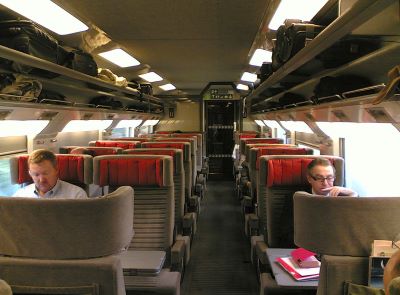 So I was an invited guest speaker at the Virtual Storytelling conference. My hosts had bought me first class train tickets from London to Strasbourg, via the Channel Tunnel. It was the first time I had ever been through it, and it was distinctly no big deal -- 20 minutes in the dark; it just seemed like a very long tunnel. There was no sense of being down especially deep. But the Eurostar train itself was great: airline-style meal service, very comfortable seats, and power points for laptops. They even had both British and European style outlets.
So I was an invited guest speaker at the Virtual Storytelling conference. My hosts had bought me first class train tickets from London to Strasbourg, via the Channel Tunnel. It was the first time I had ever been through it, and it was distinctly no big deal -- 20 minutes in the dark; it just seemed like a very long tunnel. There was no sense of being down especially deep. But the Eurostar train itself was great: airline-style meal service, very comfortable seats, and power points for laptops. They even had both British and European style outlets.
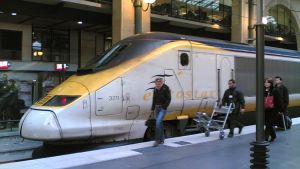 The Eurostar ends in Paris, where I walked from the Gare du Nord (North Station) to the Gare de l'Est (East Station), a matter of a quarter mile or so, although it could be better signed. The Gare de l'Est had a sculpture on top and the word Strasbourg engraved beneath it, so I guess it was built specifically for that destination. It was fun being back in France. Most of the time I'm going to places where everyone speaks excellent English, but in France I got to use my schoolboy French and it served me in pretty good stead. Nobody snubbed me or ignored me; in fact I got a warm welcome wherever I went.
The Eurostar ends in Paris, where I walked from the Gare du Nord (North Station) to the Gare de l'Est (East Station), a matter of a quarter mile or so, although it could be better signed. The Gare de l'Est had a sculpture on top and the word Strasbourg engraved beneath it, so I guess it was built specifically for that destination. It was fun being back in France. Most of the time I'm going to places where everyone speaks excellent English, but in France I got to use my schoolboy French and it served me in pretty good stead. Nobody snubbed me or ignored me; in fact I got a warm welcome wherever I went.
The train on to Strasbourg was almost as nice as the Eurostar and similarly fast. I've never been to Strasbourg before, but I highly recommend it. It's in Alsace, which is culturally part-German, part-French (the Alsatian language is a dialect of German), and was a part of Germany between 1870 and 1918. The annual Christmas market was going on as it has for several centuries, drawing people from all over the region. The shops were brightly lit and full of beautiful things and the smell of hot spiced wine was everywhere. Vendors sold roasted chestnuts and soft pretzels from street stalls; bratwurst and beignets on the same stand. The center of the city is one big pedestrianized shopping zone; the only vehicles are the spiffy high-tech trams that glide, almost silently, through the streets. The streets are narrow, and still have medieval names: Street of the Halbardiers, Square of the Old Wine Market, Street of the Jews. They're lined with half-timbered buildings that somehow survived two world wars. The cathedral, vast, deeply-carved red stone, towers over all.

The next morning I headed off to the conference, being held in the Munsterhof, a building where Mozart and Haydn had given concerts... I was distinctly aware of walking in their footsteps. I tried to imagine the room filled with ladies in magnificent Baroque dresses and men in breeches and powdered wigs. By comparison, the 100 or so academics gathered there seemed a bit frumpy.
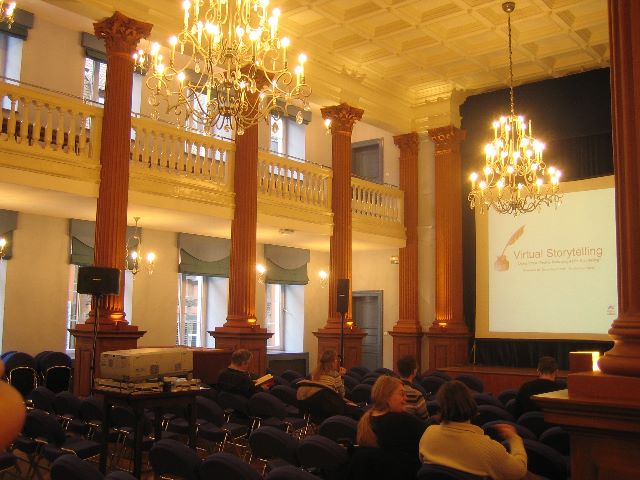
On the other hand, they had fascinating things to say. "Virtual" was very broadly construed for this conference, so it wasn't just about head-mounted displays and gloves. There were talks on all kinds of interesting uses of input and output technology: museum exhibits, interactive music displays, research on children using dolls that record the children's movements, and many other things. "Storytelling," too, was pretty broadly interpreted. I think I was the only person there from the conventional game industry; the only person who was actually an entertainer by trade.
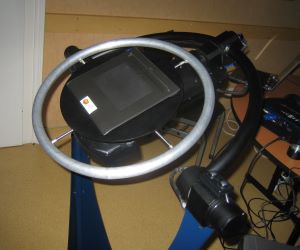 I missed Janet's talk, unfortunately, but at least it's in the Proceedings. Ken's was fascinating. He's clearly one of those multitalented people who juggles about six different, incredibly imaginative projects at once. Janet made a crack about how he makes everything look easy... provided that you're Ken Perlin.
I missed Janet's talk, unfortunately, but at least it's in the Proceedings. Ken's was fascinating. He's clearly one of those multitalented people who juggles about six different, incredibly imaginative projects at once. Janet made a crack about how he makes everything look easy... provided that you're Ken Perlin.
My own talk was called "Letting the Audience Onto the Stage: The Potential of VR Drama." It rambled around a lot, but my key point was that the chief benefit of VR technology was not in presenting worlds that seem real (we're already pretty good at that) but in letting people present themselves as other than they are. The mask has been a tool of drama that goes back to the ancient Greeks. VR technology could let you really act, act like an actor, in a virtual world. Anyway, the PowerPoint slides are online in PDF format, so you can read it if you're interested.
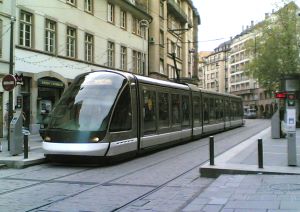 Thanks to Gerard Subsol and the organizers of Virtual Storytelling '05 for their hospitality and excellent program. I hope they invite me again sometime.
Thanks to Gerard Subsol and the organizers of Virtual Storytelling '05 for their hospitality and excellent program. I hope they invite me again sometime.


<< Home